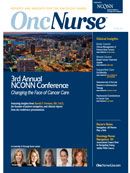Publication
Article
Oncology Nursing News
Oncofertility: Updates on Fertility Preservation Related to Cancer Care
Author(s):
Awareness and treatment of oncofertility have been given a tremendous boost over the past 5 years by the Oncofertility Consortium.
Teresa K. Woodruff, PhD
Awareness and treatment of oncofertility have been given a tremendous boost over the past 5 years by the Oncofertility Consortium, a national interdisciplinary research network dedicated to fertility preservation and sparing for patients with cancer. Teresa K. Woodruff, PhD, the director of the Oncofertility Consortium, discussed oncofertility at NCONN 2011.
Approximately 800,000 young women in the United States face reproductive issues related to cancer treatment, and 40,000 new cancer patients join this list every year, according to Woodruff, a Thomas J. Watkins Professor of Obstetrics & Gynecology at the Northwestern University Feinberg School of Medicine and professor of Biochemistry, Molecular Biology and Cell Biology in the Weinberg College of Arts and Sciences. Studies report that survivors with fertility issues experience increased depression, anxiety, and stress.
To help these patients, Woodruff said the Oncofertility Consortium seeks to increase overall awareness of reproductive issues related to cancer treatment, gather data to determine the risk of sterility and early menopause for young women, and facilitate the delivery of existing and emerging reproductive treatment technologies to the patients who need them. The Consortium, which is headquartered at Northwestern University, provides >2700 oncofertility consultations each year.
Oncofertility intervention should take place at diagnosis, or even earlier if genetic screening reveals patients are at risk for certain cancers, Woodruff said. Early intervention is crucial because fertility preservation often involves procedures that take place before cancer treatment begins.
Nurses Perspective


Paula Sanborn, RN, BSN, CPN (left) Stacy Whiteside, RN, MS, CPNP (right) Hematology/Oncology Nationwide Children’s Hospital Columbus, Ohio
The Oncofertility presentation brought forth a mission and message of hope in helping some of our current cancer patients and survivors achieve their lifetime goal of having a family. The message was powerful and encouraging for those of us who are caregivers of adolescents and young adults who seek guidance about their fertility options.
As medical professionals in the oncology field, we aspire to guide our patients and their families through these difficult conversations with a sense of hope and accuracy.
Teresa K. Woodruff, PhD, offered insight into cutting-edge research and basic science breakthroughs in follicle growth and egg preservation.
The conversations surrounding reimbursement of these procedures were very helpful in guiding our patients with concerns of the cost of such technology and provided potential financial resources for their oncofertility options.
We also gained insight into multiple websites and an iPhone application that are excellent resources for our patients and their families in guiding them through the process and gaining up-to-date information about current practices and research.
This presentation will undoubtedly impact our current practice and ignite a sense of urgency in supporting programs and research by the Oncofertility Consortium and other related fertility preservation initiatives.
Woodruff also noted the importance of informing patients that fertility issues can develop long after treatment ends. Some women are not immediately sterile following treatment, and can even experience the return of a somewhat normal menstrual cycle. However, cancer treatments can cause menopause to start 5 to 10 years earlier than in the average healthy woman. Survivors who think they are in the clear after treatment could eventually become sterile.
Treatment
At NCONN 2011, Woodruff highlighted several oncofertility options:
Embryo and Egg Banking
Embryo banking involves the freezing of fertilized eggs for future use. Prior to cancer treatment, a woman receives hormone injections to increase egg production. Through in vitro fertilization, the eggs are then removed and combined with the partner’s or donor’s sperm in a laboratory dish. After fertilization, the embryos are frozen until they are used to impregnate the woman.
With egg banking, the eggs are extracted and frozen instead of fertilized. They are then thawed and fertilized at a later date. Success rates for pregnancy are lower with egg banking than with embryo banking.
Ovarian Tissue Cryopreservation
Ovarian tissue cryopreservation provides an option for patients who are too young or who are not candidates for embryo or egg banking, or do not want to receive the hormone treatments required for the banking process. The procedure involves removal of a woman’s ovary prior to receiving chemotherapy and/or radiation. Ovarian tissue is then frozen and can later be implanted back into the patient through an ovarian tissue transplant. Pregnancies have resulted from this method.
The Oncofertility Consortium is also working on isolating follicles and enclosed eggs from the ovarian tissue, and fertilizing the eggs in vitro. The procedure has been used to impregnate mice but has not yet been successful in humans.
Reimbursement
Woodruff said insurers are often hesitant to reimburse women for oncofertility care because of a lack of clinical data. The Oncofertility Consortium is working to produce the data, and in the meantime is advocating for patients. “We are sending the information to these insurers, and hopefully we’ll get reimbursed for many of these costs,” Woodruff said.
Resources
The Oncofertility Consortium offers a patient website at MyOncofertility.org. Its main website (oncofertility. northwestern.edu) has resources for both oncology patients and oncology professionals. Other resources include the National Fertility Hotline at (866) 708-3378 and the iSaveFertility iPhone app, which provides a quick reference guide to fertility preservation.

Latest Conference Coverage

Zongertinib Elicits Durable Responses in Pretreated Advanced HER2-Mutant NSCLC

Lenvatinib Shows Efficacy in Advanced HCC Post-Progression on Atezolizumab/Bevacizumab

Sacituzumab Govitecan Does Not Significantly Improve OS in Pretreated Urothelial Carcinoma

Active Monitoring Is Noninferior to Guideline Concordant Care in Low-Risk DCIS
2 Commerce Drive
Cranbury, NJ 08512





